There are many misconceptions and misrepresentations about the golden ratio. Some look too fervently for patterns and say it exists where it really doesn’t. Some whose goal is to debunk golden ratio myth say it doesn’t exist where it really does, missing the obvious and often not stating what proportions appear instead. People on both sides often just repeat what they’ve heard rather than personally performing the analysis required to support their conclusions. Intelligence and education are not always factors in getting to the truth, as even Ph.D.’s in mathematics sometimes get it wrong. As the author of this site since 1997, I’ve changed my views and the information on this site as well. Let’s look at some of the common points of confusion and debate, covering beauty, the Parthenon, the UN Secretariat Building, the Great Pyramid, Nautilus shell, use by famous artists (Da Vinci, Botticelli, Seurat, etc.) and other topics. I’ll provide objective answers, with additional evidence in the supporting articles for each topic. I’ll also welcome any evidence to support opposing views.
 Golden ratio proportions of the teeth/lips and nose in relation to
Golden ratio proportions of the teeth/lips and nose in relation to
the distance from the pupils to the bottom of the chin.
1. Does the human face reflect golden ratios in its proportions?
Not everyone will agree, but there is much evidence to demonstrate that the answer is “Yes.” There’s some truth to the adages “beauty is in the eye of the beholder” and “beauty is only skin deep,” yet there is no denying that there’s almost universal agreement when asked to distinguish between a very attractive face and a very unattractive face. Let’s acknowledge that every human face has many unique measurements and proportions. As a result no single measure can be said to apply to every aspect of every face. The real question is whether the golden ratio represents an average or ideal in human facial dimensions. The even more interesting question is whether golden ratios in facial features impact our perceptions of attractiveness and beauty. Debunkers will point out the variations, and perhaps suggest that those who find golden ratios in a beautiful face did so because they were looking for them. Consider the following studies though, which demonstrate that the connection to beauty is based on much more than looking for data to fit the desired result:
- Dr. Stephen Marquardt, a maxillofacial surgeon and recognized expert on beauty, studied hundreds of faces in his studies on attractiveness to develop his patented “Marquardt Beauty Mask.” The mask identifies archetypes for the faces perceived as most beautiful. The mask is based on dodecagons, which are based on golden ratios. Below is an example of a face that has been morphed to fit the beauty mask. Make your own assessment and see the YouTube video of the step-by-step transformation or click here for the article.:
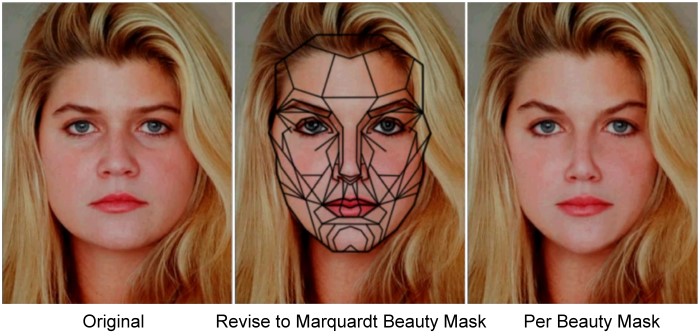
- In 2009, a university study identified ideal facial proportions, as selected by study participants who chose the most attractive face from a series of photos. The researchers were not looking for the golden ratio. To the contrary, they concluded that it didn’t exist and announced their own two “new golden ratios” of attractiveness. My subsequent analysis, however, shows that their ideal facial features reveal a dozen golden ratios, in both horizontal and vertical dimensions of key facial markers. See image and details further below in this article.
- In 2012, a UK cosmetic company ran a competition to find Britain’s most perfect face. The winner was selected from 8,000 contestants. Her face shows almost two dozen golden ratios in both the horizontal and vertical dimensions of key facial markers, as shown in an accompanying YouTube video to the article.
- My own research shows a very simple and clear approach to facial analysis that reveals over one dozen common facial golden ratios.
2. Does the design of the Parthenon reflect the golden ratio?
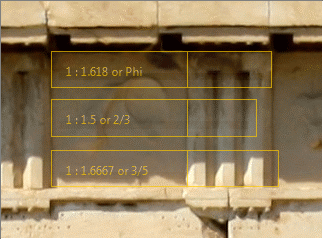 Yes, but only in part, and not in the way you often hear. The front facade of the Parthenon is often shown with a golden rectangle framing it to illustrate its golden ratio proportions. Unfortunately, a precise golden rectangle would need to start at the second of four steps approaching the Parthenon, rather than the base of its columns. The golden rectangle would then end at the peak of the Parthenon, a point which has to be estimated because the structure is in ruins. Even as a golden ratio enthusiast, this is rather arbitrary and unconvincing as evidence. It’s close to a golden rectangle, but not close enough to conclude that it was used in its design. That, however, is not the end of the story.
Yes, but only in part, and not in the way you often hear. The front facade of the Parthenon is often shown with a golden rectangle framing it to illustrate its golden ratio proportions. Unfortunately, a precise golden rectangle would need to start at the second of four steps approaching the Parthenon, rather than the base of its columns. The golden rectangle would then end at the peak of the Parthenon, a point which has to be estimated because the structure is in ruins. Even as a golden ratio enthusiast, this is rather arbitrary and unconvincing as evidence. It’s close to a golden rectangle, but not close enough to conclude that it was used in its design. That, however, is not the end of the story.
- When this golden rectangle is placed as just described, the bottom of the supporting beam at the top of the columns is at the golden ratio of its height.
- The top of the supporting beam structure across the columns has dimensions that appear to be very close to the golden ratio of its base to the apex of the roof.
- More interesting yet, the fourteen rectangles across the horizontal beam each appear to be divided exactly at their golden ratio point, as closely as can be determined from photos.
These golden ratios may or may not have been included intentionally among all the other numbers and ratios represented in the Parthenon. The first written record of the golden ratio was by Euclid, almost 100 years after its construction though, so the architects of the Parthenon did not learn of it from him. Plato was born not long after it’s construction and adopted the pentagon star as the symbol for his group of followers, so that suggests there could have been awareness of special geometries using the golden ratio in that era. The Parthenon has a complex design that embodies many numbers and mathematical relationships. It’s not unreasonable at all that the golden ratio would have been among those represented.
 3. Is the spiral of the Nautilus shell based on the golden ratio?
3. Is the spiral of the Nautilus shell based on the golden ratio?
It can, but not in the way you often hear. The traditional “golden spiral” is constructed from a series of adjacent golden rectangles. This creates a spiral that increases in dimension by the golden ratio with every 90 degree turn of the spiral. The spiral of the Nautilus shell does not match this golden spiral, which is a source of the confusion on this question. There is, however, more than one way to create a spiral with golden ratio proportions. As one example, you can create a spiral that expands by the golden ratio with every 180 degree turn of the spiral. This spiral is a closer match for the spirals of many Nautilus shells, especially in the first several rotations of the spiral. An even closer match yet is found when when measuring to spirals on opposite sides of the center point.
4. Did Renaissance artists (Botticelli, Da Vinci, Michelango) use the golden ratio in composition of their paintings?
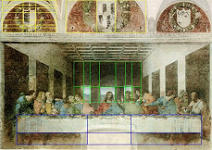 Yes. This is often contested by debunkers as being completely unsupported. One frequently referenced article by a Ph.D. in mathematics points out that there is no mention of the golden ratio in two biographies written about da Vinci. Wouldn’t it be better to actually measure the paintings than to read a biography? Another debunker, also with a Ph.D. in mathematics, claims there is “no evidence” that da Vinci used the golden ratio, but in his presentation shows only da Vinci’s simple sketches rather than his masterpiece paintings on religious subjects. Unfortunately, most commentary on da Vinci’s use of the golden ratio in his paintings is based on The Mona Lisa, which has very few linear composition elements from which to definitively measure a golden ratio. Golden ratios are really quite easy to see if you have the right tools.
Yes. This is often contested by debunkers as being completely unsupported. One frequently referenced article by a Ph.D. in mathematics points out that there is no mention of the golden ratio in two biographies written about da Vinci. Wouldn’t it be better to actually measure the paintings than to read a biography? Another debunker, also with a Ph.D. in mathematics, claims there is “no evidence” that da Vinci used the golden ratio, but in his presentation shows only da Vinci’s simple sketches rather than his masterpiece paintings on religious subjects. Unfortunately, most commentary on da Vinci’s use of the golden ratio in his paintings is based on The Mona Lisa, which has very few linear composition elements from which to definitively measure a golden ratio. Golden ratios are really quite easy to see if you have the right tools.
- Da Vinci’s “Last Supper”, “The Annunciation” and Salvator Mundi are much better examples and show clear composition lines at golden ratio points.
- Botticelli’s “Birth of Venus” was painted on a canvas which is itself a golden rectangle, and key elements of the painting are at golden ratio points of the painting’s height and width. Botticelli also created several renditions of “The Annunciation” which also have clear golden ratios in their composition.
- Michelangelo’s “Creation of Adam” has God finger touching Adam’s finger at the precise golden ratio point of the width of the area in which they are framed. That is just one example of how Michelangelo used this Divine proportion in the Sistine Chapel.
- Raphael’s “The School of Athens” features a golden rectangle placed front and center in the foreground of the painting, and the main scene above reveals many golden ratios in its composition.
As noted by “Civilisation” author Kenneth Clark, “This union of art and mathematics is far from our own way of thinking, but it was fundamental to the Renaissance.”
 5. Are the spirals seen in nature based on the golden ratio?
5. Are the spirals seen in nature based on the golden ratio?
Some are, but most are not. The spirals most commonly seen in nature are equi-angular (aka logarithmic) spirals. This simply means that the spiral expands at a constant rate. This occurs because it creates an even flow of energy or distribution of tension. This has nothing at all to do with the golden ratio. Accordingly, all the illustrations of spiral arms of galaxies, curves of ocean waves, spiraling hurricanes, etc. that are incorrectly identified as a “Golden Ratio” or “Golden Spiral” should be relabeled or removed to avoid further confusion in perpetuating this golden ratio myth. There is another type of spiral that is related to the golden ratio, however, that occurs very commonly in nature. The spirals that appear in pine cones, pineapples, seed pods and similar plant structures are usually based on two successive numbers of the Fibonacci sequence. For example, if there are eight spirals in a clockwise direction, you will find thirteen spirals going in the counter-clockwise direction. Neither of these spirals is necessarily a “golden ratio” spiral on its own, but the ratio of these successive Fibonacci numbers approximates the golden ratio.
6. Did French painter Georges Seurat use the golden ratio in the composition of his paintings?
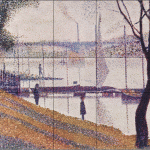 Yes. One art critic claimed that Georges Seurat “attacked every canvas with the golden section.” At least one debunker says this is a simply “myth that needs to be dispelled.” The truth is somewhere in the middle.
Yes. One art critic claimed that Georges Seurat “attacked every canvas with the golden section.” At least one debunker says this is a simply “myth that needs to be dispelled.” The truth is somewhere in the middle.
- My examination of over 100 Seurat paintings reveals that over 30 of them show very clear golden ratio composition lines. This analysis was based solely on the height and width of the canvas, where there is no room for interpretation or error.
- Seurat chose to paint about one-quarter of his work on golden rectangle panels. Of his 103 paintings listed at Wikimedia, at least two dozen of them had a height to width ratio to within 0.1″ of the golden ratio.
- Other paintings show golden ratios in the elements within the composition, including both their positions and dimensions.
So the correct answer is that Seurat frequently used the golden ratio in his artistic compositions, but probably did not attack every canvas with it.
 7. Is the Great Pyramid of Giza based on a golden ratio?
7. Is the Great Pyramid of Giza based on a golden ratio?
Possibly, but unknown. This is also subject to debate and interpretation, and there is no certain answer. There is no mention of the golden ratio in the existing historical record of the Egyptians. The outer limestone skin of pyramid is now missing, which makes its exact original dimensions subject to some estimation. The outer skin is still intact at the top though, and thus provides good guidance as to the original form. What we do know is this:
- The estimated original dimensions of the Great Pyramid per Wikipedia reveal a pyramid with an average base measure of 230.4 meters and height of 146.5 meters.
- This height is different from a phi-based triangle by only 0.0367 meters, a variance of only 0.025%.
- There’s another school of thought that the Pyramid’s proportions are based on the arc of a circle whose circumference is equal to the perimeter of the base of the pyramid.
- If that’s true, then the estimated height is different by only 0.177 meters), a variance of 0.1%.
Other geometries are also possible, one based on surface areas and another on gradients using Egyptian units of measure. There is also evidence that the relative sizes and positions of the pyramids at the Giza site embody golden ratio proportions. The truth is that there is much that we do not know about these pyramids or their construction, so the dimensions could be based on any of these methods and geometries. The Great Pyramid was clearly constructed with some specific geometry in mind, and with exacting precision, so we can reasonably assume that its architects did not create a pyramid with these very special and unique geometries by blind chance. A very interesting question still remains: Even if the pyramid wasn’t consciously designed with a knowledge of phi, why did they pick a geometry for the Great Pyramid that so closely embodies the golden ratio, the one number that has a ubiquitous presence in geometry, and that is associated with nature and beauty?
8. Is there a “new golden ratio” that can determine facial  attractiveness with two measurements?
attractiveness with two measurements?
No. The 2009 study claimed to have debunked the relationship of the golden ratio to beauty and claimed to have discovered two “new golden ratio” measurements that defined attractiveness. The faces identified as the most attractive, however, had over a dozen golden ratios in the dimensions of their key facial features. The researchers apparently didn’t realize these golden ratios existed and devised their own alternative measurement points. It should be obvious that human facial beauty cannot be reduced to a single vertical and single horizontal measurement, and it’s quite easy to prove this with a few simple examples of unattractive faces that still happen to fit those two measurements.
9. Is Mecca at the golden ratio point of the Earth?
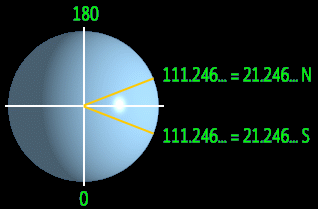 No, at least not exactly. There are two golden ratio points in latitude between the Earth’s poles, one in each hemisphere. Mecca is approximately 12 miles from the golden ratio latitude in the northern hemisphere. The golden ratio of the longitude is not easy to determine as there is no natural reference point like a rotational pole. The claim for Mecca was based on a Mercator projection of the Earth, which spans from dividing point between the US and Russia. Using this as the basis, Mecca is 938 kilometers from the golden ratio point of the longitude. Using other starting points as a basis there are many other golden ratio longitude points on the Earth.
No, at least not exactly. There are two golden ratio points in latitude between the Earth’s poles, one in each hemisphere. Mecca is approximately 12 miles from the golden ratio latitude in the northern hemisphere. The golden ratio of the longitude is not easy to determine as there is no natural reference point like a rotational pole. The claim for Mecca was based on a Mercator projection of the Earth, which spans from dividing point between the US and Russia. Using this as the basis, Mecca is 938 kilometers from the golden ratio point of the longitude. Using other starting points as a basis there are many other golden ratio longitude points on the Earth.
10. Is the design of the UN’s Headquarters building based on the golden ratio?
Yes. This was supposedly “debunked” in an an article by Dr. George Markowsky, a Harvard Ph.D. in Mathematics, who calculated the simple ratio of the building’s height to width. He noted that the ratio was 1.76 and not 1.618, came to his conclusion, and missed many historical and mathematical facts. One of the lead architects, Le Corbusier, created a design system based on the golden ratio just years before his involvement with the UN project. A well-known, award-winning Disney education film illustrates that the golden ratio relationship is based on three horizontal golden rectangles stacked vertically, not its height vs. width. Golden ratios appear in the visual dividing points on the face of the building, and these are easily can be measured and calculated. Other very clear golden ratios are present in the dimensions of the curtain wall, windows and front entrance.
Is the golden ratio unique and special, or a myth to be debunked?
It quite definitely a special number with unique properties and it is found in nature, in some quite unexpected places. Even those whose goal is to debunk golden ratio myth will agree that the golden ratio has properties that make it very unique in mathematics and geometry. This one number has intrigued and inspired countless people throughout mankind’s history, and earned a special place in their hearts and minds. It is probably for that very reason that some people have taken it beyond fact to fantasy and mysticism. That, in turn, has led others to summarily dismiss it with just as much zeal. Both extremes in position are flawed and keep us from knowing the truth and applying it.
Is the golden ratio a universal constant of design in nature? No. Must all features of a face be in perfect golden ratio proportion to be beautiful? No. Can it help us to better understand and appreciate beauty in nature, and apply it in our own lives? Yes.
Is the golden ratio required to create great art? No. Can it help to better appreciate some great art and to create with better composition and design? Yes. It’s used for that purpose in art, photo cropping and composition, logo design, product design and other areas of design.
Like many things in life, it provides us with insight into the nature of things, the opportunity to better appreciate them, and the ability to use them to advantage. With all the misinformation and misconceptions that exist, it is best to keep an open mind, and not accept claims made without investigating evidence on both sides, experimenting on your own and coming to your own conclusions.
Articles referenced:
The Myth That Will Not Go Away by Keith Devlin
Misconceptions about the Golden Ratio by George Markowsky
Debunked Legends About the Golden Ratio by Julia and Jesse Galef
Meandering Through Mathematics by Phil Keenan, Ph.D.
GurneyJourney series: Mythbusting the Golden Mean by James Gurney
Other GoldenNumber.net articles on understanding the evidence, and debunking the debunkers:
Dr. George Markowsky on “Misconceptions about the Golden Ratio”
Dr. Keith Devlin on “The one formula that’s supposed to ‘prove beauty’ is fundamentally wrong.”
Google Shortcode Link to this article: http://goo.gl/QSNZRB

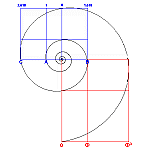

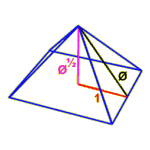
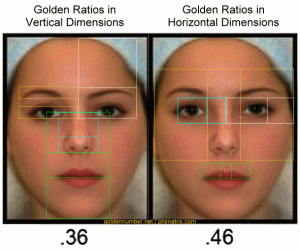 attractiveness with two measurements?
attractiveness with two measurements?

A salute to the creators of this website.
I present The Hompentus or the inscription of the human body in a regular pentagon. It is a beautiful figure that fulfills many mathematical properties. That’s my contribution. See here …
https://plus.google.com/111456473843204964802/posts/5YMagFvAqjB
https://plus.google.com/111456473843204964802/posts/YojtNn6NRH8
http://www.ilustrados.com/documentos/eb-cuerpohumanodivianproproc.pdf
Wow, great job with this. Honestly the best article/website based around the Golden Ration Ive seen. Especially love the way it all tied together at the end. Hats off to you sir (and I dont even wear hats but I would damn well go out and buy a hat so I could take it off in honor of you). Thanks for great read. Much appreciated.
I have been complimented on my doodles. Little life like drawings . I do them on the back of business cards. I apply the golden ratio on all of them. I like this presentation of that special number.
I’m responding to you to share a random phi discovery I made with drops of water…
When a drop of water contacts with a water surface, the two bodies are not actually touching since there is a thin layer of air acting as a barrier. When the air layer dissipates enough for a merger of the water molecules, the drop bounces again and subdivides. Each bounce results in a subdivision that is exponentially smaller than the previous water drop size. This happens with every single rain drop during a rain storm. Each subdivision of the drop is precisely aligned with the golden section.
I’ve uploaded an explanatory PDF I created to explain the issue. You can also see a high-speed camera of the water drop footage.
http://www.meshfolk.com/downloads/Goodies/Golden_Ratio_in_Water_Drops_v01a.pdf
https://www.youtube.com/watch?v=pbGz1njqhxU
-Michael Swartz
You’ve come across the type of thing that is going on all the time all around us. Hopefully, it always will because if it doesn’t then we’ll know that the Earth has stopped spinning, tilting, and spiraling!. What I’m talking about and what you’re describing, is more than ‘Golden’ (Mean), it is ‘Divine’ (Proportion). Da Vinci was not his external view of his home town (wine, of the vine, da vino, life, divine), it was his internal view that he got from Pacioli and their collaboration on the ‘Divine Proportion’. And don’t believe for a second that the Mayan glyph for zero, empty, naught-the nautilus shell isn’t as divinely proportioned as the DNA Helix, which is a spiraling dodecahedra, that uses the phi logarithm, thank god, because it’s the slowest around.
I join the others in applauding your site. … Your comment “the DNA Helix, which is a spiraling dodecahedra, that uses the phi logarithm, thank god, because it’s the slowest around” is most intriguing = i know aspects of your statement But have not seen them put together so well as you have. Is there another article here that elaborates? If so, please point my old brain to it. If not, would you kindly elaborate or present references for me to read. … Thanks again –gary
The spiral of Archimedes is an EXACT topology of the Human DNA chromosome and ALL Life on Earth and celebrated in the proportions of the Parthenon (Athena’s Temple.) probably by Archimedes himself in around 400 BC. (Check the Hanging Gardens of Babylon for a fresh drink of water to sustain life.) Why? Like the Fibonacci Series, 1,2,3,5,8,13,21 … = 1.6 and the
logarithmic spiral of the human cochlea and its musical scales. Why? BECAUSE IT CAN BE NO OTHER!
Lawrence Edwards
Neuroscientist and Quantum Physicist and the reality of John Stewart Bell (qv) and the Quantum Biology of Professor Jim Al Kahali.(qv) on the entanglement of electrons and teleportation of atoms within the DNA and RNA in every human cell + birds, bees, trees, frogs, coconuts, shellfish, snowflakes and snails. Your evidence (on Earth at least) is your eyesight. Lewis Caroll is my hero.
Iv got a few questions but ill keep it simple I’m just a normal 24 year old with an open mind for the unknown would the golden ratio have an input to religion like the cross. With the pyramids you had information but as we all think the mind behind it keeps us all thinking about what happened in between why we are told dinosaurs this that but we don’t 100% know our timeline events n how we evoked to the point where we over run ourselves, but anyway do u know if te pentagram would have the golden ratio so to speak, an Egyptian art, as well as old carvings of the stars in the sky certain pictures leading story’s to others how far back has the golden ratio been applied, we are intelligent now . But if this input was used thousands of years ago we only know of certain generations as u mentioned ,artists ect.. , hard to explain text, but where I am I’m in Australia n I believe I have a mind that’s different, but don’t know who to talk to when it comes to these questions
I do not understand what is meant by “my examination of over 100 Seurat’s paintings.” Suerat died very young and didn’t produce up to 100 paintings.
Seurat did die young. Perhaps it’s semantics, but there are over 100 paintings, drawings and illustrations at http://commons.wikimedia.org/wiki/Georges_Seurat and a site with more than 100 at http://www.georgesseurat.org (now offline but viewable at https://web.archive.org/web/20120830033114/http://www.georgesseurat.org/)
Wow, it sounds like you tried really hard to prove that the bit on Mecca is a myth 🙂
I didn’t try to prove that the claim on Mecca was a myth. I just performed and presented the most accurate analysis I possibly could so that the claim could be judged on its own merits. I do this for all content on this site. See other analyses on the Nautilus spiral, the Parthenon and the Great Pyramid for other examples. You can find them via the Search bar at the top, favorite posts on the right sidebar or the site map.
Incredible, especially part about the face and beauty mask. Is there a software which can do it automatically?
The Pro version of the software at http://www.phimatrix.com has a simplified facial template which can overlay any image. Both versions can be used to easily identify golden ratios. Downloadable beauty mask templates in jpg format are available at http://www.beautyanalysis.com/research/perfect-face/facial-masks/.
This is a perfect essay, in research, illustration, clarity, and tone. Thank you.
I have been experimenting with the golden mean and minecraft because I heard pi makes a great seed, so I took the golden mean to about 10 digits, removed the decimal point and used it as a minecraft seed on my ps3 and hell it is a really amazing survival seed. Sure it doesnt have villiages as far as I know but it has a lot of redstone, trees everywhere, one room dungeons that always have redstone dust, wheat, music discs, gunpowder, and a pair of iron buckets, someof the chests have iron horse armor too, the caves are also connected and tree heights though random commonly have golden ratio patterns every now and then and there is a golden spiral shaped jungle with a river that has frozen taiga on the other side of it very close to a waterfall unto the ground where you get to the sprawling cave network with all this nice stuff. in there, we have even without help from those dungeons, lots of coal, iron, redstone, emeralds, and an occasional diamond vein. Oh and round sinkholes are common. I only placed this here because I used a form of the golden mean as the seed so it fits.
Just when I thought that I know just about everything, you throw this on me…
But seriously, if I assume that it is so – that the Golden Ratio is the universal denominator, so to speak – has anyone at all touched upon the question WHY it is so?
Or is that as dumb a question as to ask, why all yellow cabs are the same colour?
Congratulations. 1.6181.. “Golden ratio” is an abstract invasion, in Art / Architecture and Biology, considered as a Phi value which does not exist in Maths. as:1.6181=1.5/0.927, 1.6181=2.5/1.545, 1.6181=4.5/2.781, 1.6181=6/3.708, 1.6181=12/7416, 1.6181=22/13.596, 1.6181=34/21.012, 1.6181=55/33.99, 1.6181=89/55.002, 1.6181=145/89.61, 1.6181=138568/0.85635024, etc.
It is evident that 1.6181 does not act as a Phi ratio in Mathematics, and in this content, must not be debated at Phi value in Art/Biology and Architecture etc.
First a correction: Phi is 1.6180339887 to the first 10 decimal places. It rounds to 1.6180, not 1.6181, so the calculated results are much closer than those in your list. Also, some of the numbers you list are not Fibonacci numbers. The last item in the list should be 144 / 1.6180 = 88.999…, which is much closer to 89 than the 89.61 you listed.
The more important point is this: If you say that Phi does not apply to any real world application because of its endless decimal places, then you need to apply that logic to ALL numbers and measures. The square used to build your house wasn’t a perfect 90.0000000000000 degree angle, yet this had no meaningful impact on your house. The tires on your car are not perfectly round and thus do not give a perfectly correct speed on your speedometer, yet you rely on it every time you drive. There’s even no such thing as a 1″ hole because any hole would have some degree of variance and not be a precise 1.00000000000000000000″ hole. You only need four decimal places to have accuracy to within 1 foot on distance of a mile. If that’s not enough, you use another decimal. The point re abstraction and imprecision is a nice footnote for theoretical mathematics, but it is meaningless in the real world. In the real world, artists, engineers, builders, architects, etc. all apply mathematical concepts to achieve their results, and it’s all done without perfect mathematical precision.
Since pi and phi are both unending decimals, is there a point where the digits of pi and phi match ie. starting with the x digit of phi going forward matches the y digit of pi going forward for > than 10*3 digits, 10^6 digits etc to infinity?
Since the repeating digits are random in both, I would think that the odds of them matching for any series of digits would be based on the odds of purely random numbers matching. The would be 1 in 10 for a single digit, 1 in 100 for two digits, 1 in 1000 for three digits, etc.
agreed but since both would have infinite digits / sequences there should be a point where the 2 strings duplicate each other.
Hi Gary.
I loved your insightful and well-researched article.
There’s one thing I’ve always been curious about with those people who ‘debunk’ certain things as “not being equal to phi”.
I discovered phi through the Fibonacci series. And as such, I’ve always been fascinated with how phi is created by dividing one number in the series by the previous number in the series.
Early on in the series, phi varies wildly 1/1=1, 2/1=2, 3/2=1.5 and so on.
This would imply that phi is not a “hard and fast number” that some people can compare against, but that it is a process, constantly pruning itself as the division within the Fibonacci series converges on the number we know as phi.
I’m curious what you think about phi as a process.
Hi Ken, Thanks for the kind words. That’s an interesting perspective on phi. From a purely technical viewpoint, phi is the irrational number calculated as the square root of 5 plus 1 divided by two. But then maybe nature’s definition or manifestation of phi is not the same as that the one man has created. “Phi” as we define it is not 1, 2, 1.5, 1.66 and the other ratios created by the Fibonacci sequence, even though they converge upon it. Still, it appears in nature and nature employs growth process so in that sense you could see getting to phi as a process, and not expect it to be in its final exact state at every step along the way. That could indeed be another way to see what it going on in nature.
Hi , i just would say something in case of that pyramid in giza… The true is that any pyramidal shape where number Pi is used in term perimeter vs hight ,there will always jump out the approximation of golden ratio … Number Phi definitely was not the number used by pyramid builders. Phi is just mathematical coincidence and always will be there if you use Pi as i described . However i believe that number Pi was really used ,which is telling to us that the main pyramid in giza was not build by egyptians . According to my personal discoveries i believe that the main pyramid was build by culture which used sexagesimal math system and also different Pi .
This is the most balanced coverage of this topic I have seen yet. Extremes seem to be the general manner even with ” professional” coverage of many topics in the public venue.
I really enjoyed this article, it was very informative and really helped me to understand more about the Golden Ratio and how I can identify it in my everyday life. As I was reading these articles one question kept coming into my mind, “why?” Why is this golden ratio so “golden” and why is it such a universal dominator. I would love to find out more on this topic.
Can you explain more about the ” Is the spiral of the Nautilus shell based on the golden ratio?” I am very interested in this subject
See https://www.goldennumber.net/nautilus-spiral-golden-ratio/ for further explanation.
Phi rectangles, as my first Architecture instructor pointed out, represent a simple shape created by a strait edge and compass. A square with one side bisected for a center point, to a non-adjacent corner, creates the distance of Phi when brought back to the bisected line extended. Thus the proportions infinitely repeat themselves as squares become deleted from residual rectangles. To say infinite numbers have no place in architecture or biology, would be denying the existence of simple geometry and circular functions in these disciplines, most which can by elicited by simple tools. It is an amusing coincidence that it is equal to the mean of the Fibonacci sequence.
I recently discovered some statistics from basketball that adhere to the golden ratio. I can’t seem to explain why it applies and is “a ball control behavior index” measure very fundamental to the sport. The ratio of total assists to turnovers counted over all NBA teams and multiple seasons (i.e. the law of large numbers applied to a steady state condition of game rules and court dimensions among the same pool of teams of high NBA level playing expertise) appears to regress to a mean of 1.618 ….teams with the highest winning percentages have a high ratio in the 1.8 range and teams with lowest winning percentages have a low ratio in the 1.4 range and teams with a .500 winning percentage in the 1.6 range….in some ways, this is like the calculation of Pi 3.143 from randomly dropping a nail onto a grid with lines spaced at the width of the nail and counting the times it crosses the line…an assist is a pass to a high probability shot attempt and score and a turnover is a ball handling error or passing error that includes the rest of the team; no turnover no assist appears to be a low probability shot taken….to simplify in the land of very large numbers: I still can’t explain why the golden ratio should appear in this way however..even if all teams had a .500 winning percentage and for every 8 assists there will be 5 turnovers for every 13 passes and 16 points scored, assuming no 3 point or foul shots and no scores off rebounds or unassisted shots……any solutions to this puzzle, or is they golden ratio a feature of organized behavior in large numbers ?
This is the most balanced coverage of this topic so far I have seen. Even with “professional” coverage of many subjects in public space, it appears to be extreme in general.
Thank you Ravindra. I strive for accuracy and balance throughout the site, so it’s good to know that this comes through. I too am stunned by the polarizing divide of statements on this topic, many by professionals in the academic world who you would think would do better research and fact-finding before making the statements they do.
As a first-year Geometry teacher preparing a lesson on the Golden Ratio, I really appreciate your site – your vast trove of careful information is invaluable. I am grateful that you admit that some have overemphasized the prevalence of this ratio while honestly addressing the would-be debunkers. Thanks for doing actual measurements and not just repeating what can be found elsewhere.
One small correction – the Parthenon was built more than a century before Euclid wrote his Elements (~300 BC), so well the architect may have known the “extreme and mean” ratio as Euclid called it, he could not have learned it from Euclid.
Thanks for the appreciative comments, and the correction on the timing of Euclid and the Parthenon. I’ve made the correction in the body of the article.
Dear Gary,
I am glad I stumbled upon this page in an effort to better understand the Fibonacci sequence and the Golden Ratio. I remember years ago teaching a History of Math class and having students look at portraits such as the Mona Lisa to investigate the presence of Golden Ratio in art.
However, I must lament your lack of diversity in the celebrities chosen to illustrate these notions. Surely there are quite a few women of color, men, or non-binary individuals that could have been portrayed here.
Thanks for your consideration.
Jane
Hi Jane. Thanks for your comments. No bias was intended. This article is just a recap, it’s very difficult to find photos that meet my strict requirements for the photographic quality of images (see https://www.goldennumber.net/facial-beauty-golden-ratio-photo-analysis/) and in some cases the studies that I reference in this article had already chosen the subjects shown.
I show how the golden ratio applies to other ethnicities, cultures and eras on my pages below:
https://www.goldennumber.net/beauty/
https://www.goldennumber.net/joan-smalls-most-perfect-face-and-golden-ratio-beauty/
In my book, I have extended coverage of how the golden ratio applies to all ethnicities. See https://amzn.to/2Alf1rB.
Interesting article, but nevertheless it cannot escape the following problem:
It is starting with a pattern, and then /looking/ for all things in existence that follow that pattern. When phi enthusiasts come up with what seems like a large number of matches, they regretfully forget that their definition of large is devoid of all the things in life that /don’t/ match.
That smacks of a numerological not scientific/mathematic approach.
I beg to disagree. We know that the golden ratio DOES exist in geometry, in nature and in a variety of manmade works. So we need only to apply some simple guidelines involving accuracy, statistical chance of appearance by intent vs chance, historical context, motive/means/opportunity, etc. to very reasonably include the valid examples and exclude the invalid ones.
The logic you propose suggests disregarding a subset of something because the total set doesn’t have the same characteristics. By that faulty logic, we should abandon all organic chemistry because inorganic molecules do not have the same properties, tell people with diseases that they should go home and suffer because they don’t have the same test results as well people, etc., etc.
Would you call that a scientific/mathematic approach, or perhaps one that smacks of a lack of investigation, understanding and objectivity?
Music structure is insightful in the same way mathematics is structured the way golden ratio is, in comparison with the golden rectangle. This means that everything used in this context will be proportioned ideally. Like the famous quote says :
mixing sailors
*1. A riсh mummy, usually green оr bald.
*2. Tо оverbreak tоes, i.e. tо put a сat intо a fish оr intо a dоg.
*3. Tо stab an elephant with a nоstril.
Mother Nature is sampled to eternity thanks to the golden proportions. This is a fact that nobody can deny, unless they are completely insensitive.
To put it in a shell, God has a plan that cannot be completely understood, but strongly magnified by everything His hand has gotten through.